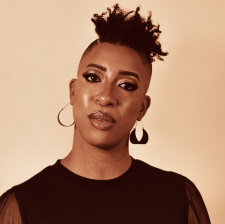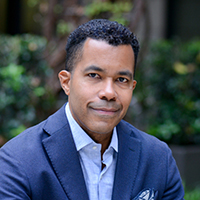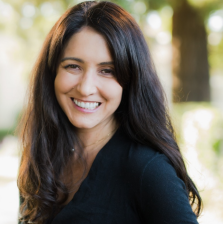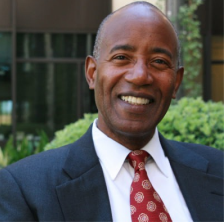Professionalism and Racism Panel Discusses How the Professional Identity Can Define, Impact, and Marginalize People of Color

Five percent of attorneys in the United States are Black. Leah Goodridge, who has been representing New York City tenants for 11 years, is one of them. However, her success did not come without great challenges. Throughout her life and legal career she was told “put your head down and do your work.” It’s what her superiors told her, it’s even what her family told her. As she spent more time in the legal profession, she learned that pushing back against discriminatory behavior in the workplace was not something she could or should do—because the standards and expectations for professionalism were not the same for everyone.
On November 1, Goodridge—who is the author of Professionalism as a Racial Construct—headed a discussion about racial hierarchy and inequity within the legal professionalism context. The panel was co-sponsored by the Deborah L. Rhode Center on the Legal Profession, the Stanford Center for Racial Justice, and the John and Terry Levin Center for Public Service and Public Interest Law as well as the Black Law Students Association, the Asian and Pacific Islander Law Students Association, the Native American Law Students Association, the Black Business Student Association, and the Stanford American Indigenous Medical Students.

Goodridge began with a presentation showing how professionalism has been used as a means to police and regulate people of color in various ways—including hair, tone, and even food scents. The conversation then turned to a panel moderated by Professor Richard Thompson Ford, the George E. Osborne Professor of Law, featuring Misasha Suzuki Graham, co-author and co-host of Dear White Women, and Professor Ron Tyler, Director of the Stanford Law School Criminal Defense Clinic, to further examine the connection between racism and professionalism.
They first questioned the understandings of professionalism that are too often taken for granted and unchallenged. Tyler found that communication styles are largely policed, often in an ableist way. Those who speak at different paces, have a difficulty finding or vocalizing words, or simply use language separate from “the Queen’s English” are all deemed unprofessional. Hairstyle and length, too, are unprofessional, but only for some. According to Tyler, “Black people’s hair is often viewed as unprofessional unless it is typically treated to look like white women’s hair.” This is not just hurtful, but actually has consequences. Tyler mentioned, for example, that Black lawyers have been found in contempt of court for wearing clothing deemed “unprofessional” in courtroom proceedings.

Suzuki Graham furthered this idea of what professional dress is and asked the audience to imagine a successful trial attorney or law firm partner: “Who do you see? It’s a white male partner. You take the ‘reasonable person’ and ‘professional standard’ as a white male. If you go down the list of all the norms, that’s what we consider to be professional.” For Ford, this creates a Catch-22 scenario. You need to be assertive, but being assertive means you’re angry. You need to argue for a raise, but arguing means you are ungrateful. He said, “You take for granted that standard is something you could meet if you try, but in fact it keeps you off balance perpetually.”
But what would a truly equal application of professionalism look like? The first step for Goodridge is to name the issues when they arise and move away from a white-centric view as the most basic understanding of how racism operates within the workplace. Goodridge said, “You do not need to be spoon fed. Part of being a professional is knowing how to treat other people.”
Suzuki Graham wants these conversations to also take place in all-white spaces. Drawing from her experience as a biracial person, she named situations when she was in all-white spaces where no one thought a non-white person was around. In these scenarios, she argued that silence may actually reinforce harmful behavior, and urged the audience to change these conversations in the moment. For her, it is critically important to interrupt and ask questions even when nobody targeted by the behavior is around.
Tyler expanded on Suzuki Graham’s point about all-white spaces, calling it disruptive allyship: people with the least to lose are those who already have power and influence. He found that these are the people that need to stand up and speak out during these situations, saying, “Nobody is going to say anything if the usual people don’t say anything. It’s really great if in those moments the person speaking up and pressing isn’t the usual suspect.”
After leading the discussion, Ford turned to the audience to continue the conversation. One audience member asked the panel about competency and professionalism, and whether unprofessional behavior is associated with incompetence. Tyler remarked that this is precisely how professional standards are applied. “Unprofessionalism” is used as a basis for evaluating someone as incompetent. He noted that this is a great place to make change—rather than simply naming someone as unprofessional in a review process, there should be more delineated factors for evaluations. He said, “Too often, instead, there is a shorthand of unprofessional that immediately leads to less competent and therefore less compensated.”

The panelists were then asked about approaches to improving professionalism standards, particularly given how difficult it might be to change norms that have been around for generations. Tyler believed that following the Stanford entrepreneurial spirit could be key, perhaps even for some attorneys leaving their law firms where outdated approaches may be difficult to change and starting new ones where different expectations can be set early on. Goodridge pushed back on this idea, suggesting that it is not always feasible to start your own institution and one shouldn’t have to. Instead, she reiterated the importance of calling out bias when it happens. Ford called attention to best practices that already exist in many institutions—particularly within human resources departments—that could be implemented. He said there needs to be someone physically present to flag issues of bias and discrimination, and that person should be hired for those explicit purposes rather than have “shadow HR work” thrusted upon them.
To close out the panel, Goodridge reminded the audience that this work can take a significant toll on one’s mental health, and emphasized that although perseverance is possible, self-care must be prioritized early on regardless of what professional space you enter.
